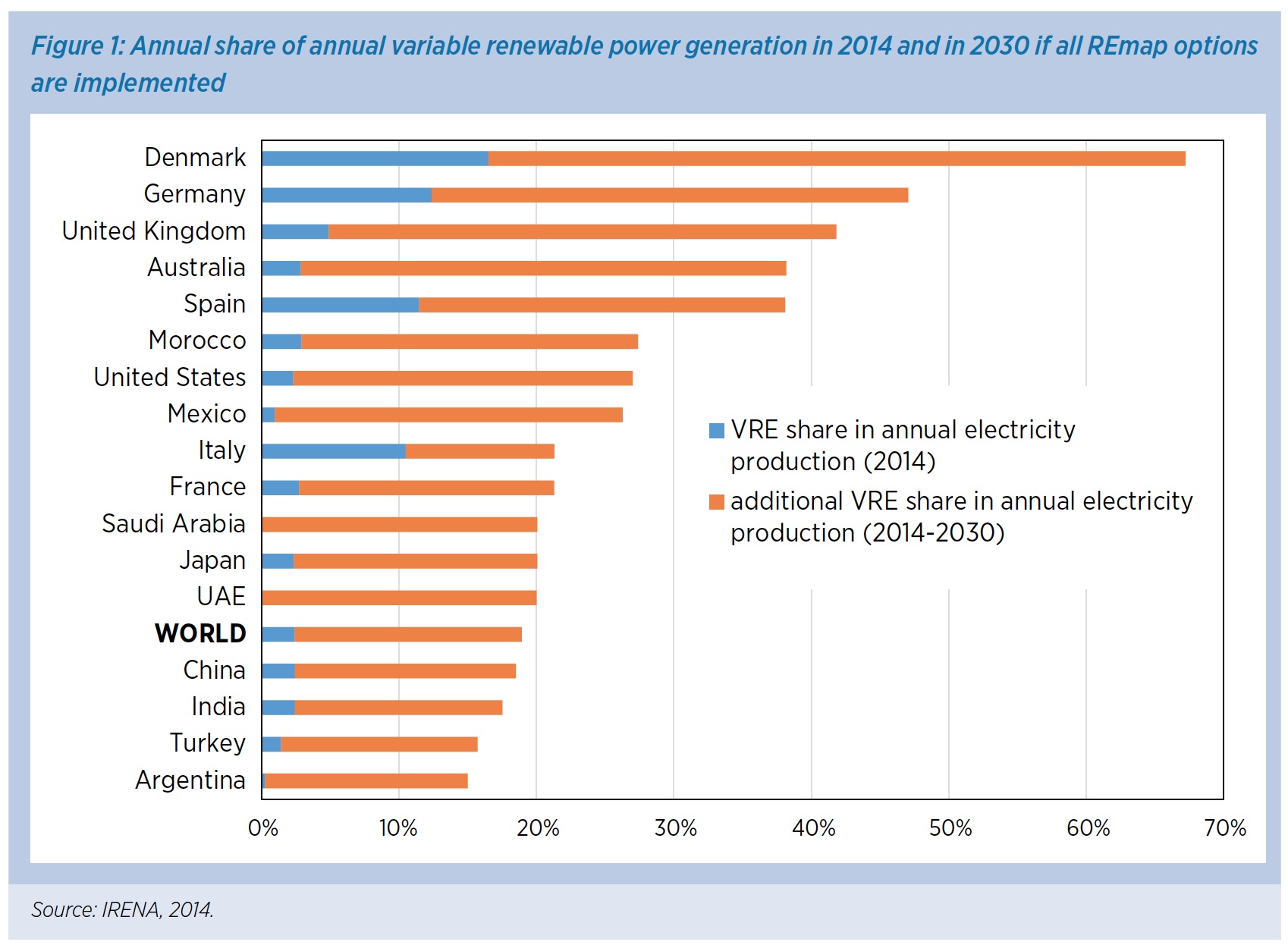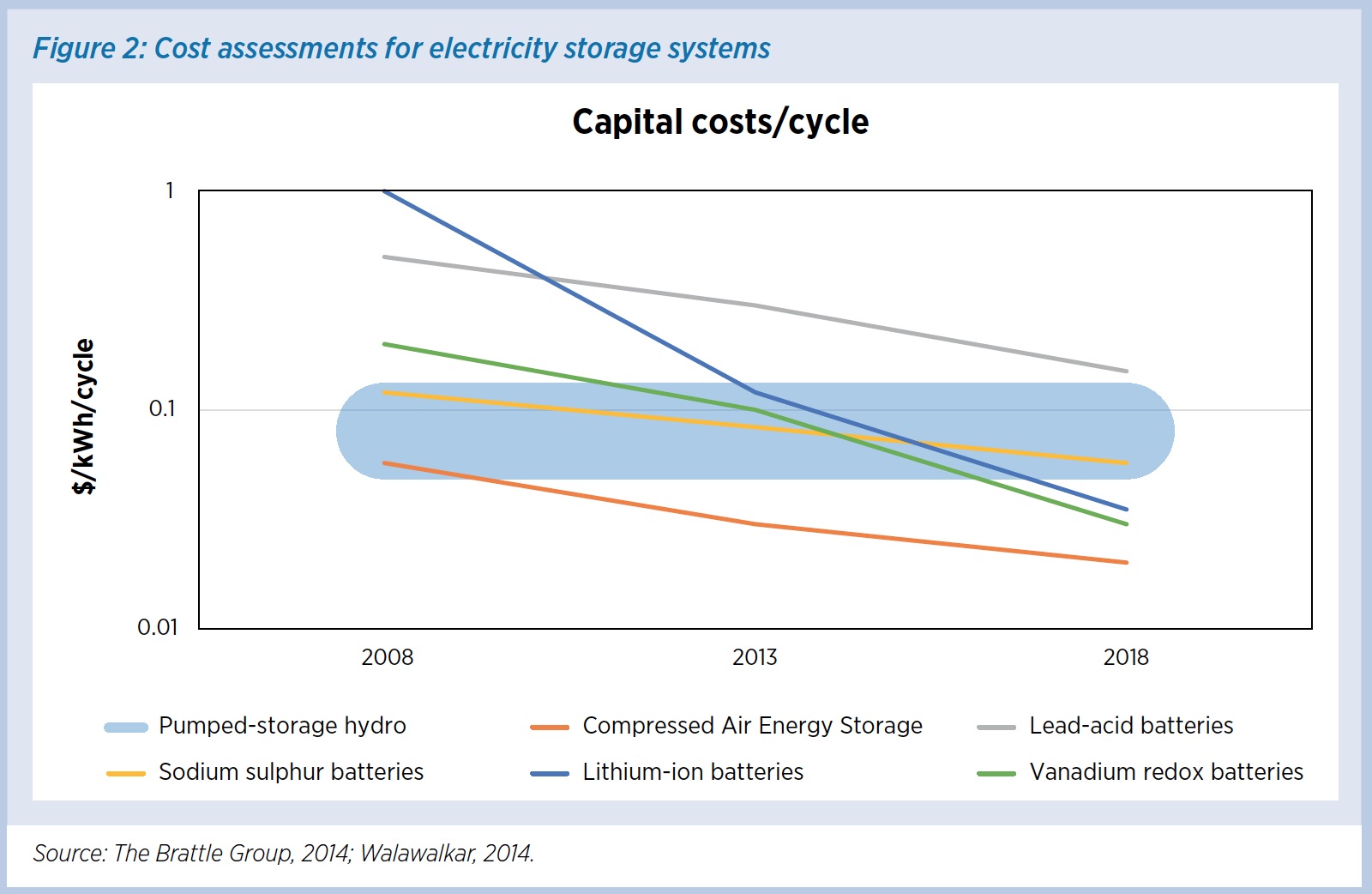INTERNATIONAL RENEWABLE ENERGY AGENCY (IRENA)
Summary of Key Findings
Electricity storage systems convert electricity into other forms of energy (e.g. potential, thermal, chemical or magnetic energy) and then reverse this process to release electricity. In the power sector, the most common form of existing electricity storage (99% of installed capacity) is pumped-storage hydroelectricity. This use electricity to pump water to an elevated reservoir in periods of excess power in the grid. In periods of high electricity demand, the water is subsequently released to run conventional hydropower turbines to revert to electricity production.
Pumped-storage hydroelectricity can start up within a couple of minutes and can thus be used to provide balancing and reserve to systems with variable renewables. Their main drawback is their relatively low roundtrip efficiency of around 70-80%, as well as geographical restrictions. These are dictated by the need for relatively large water reservoirs and large elevation variations between lower and upper reservoirs to provide sufficient capacity.
In the transport sector and in remote regions with unreliable or no centralised electricity grid, lead-acid batteries are the dominant technology to store electricity or provide backup capacity. Lead-acid batteries have been relatively cheap but their limited efficiency and lifetime made them less suitable for renewable energy integration. The relatively recent developments in consumer electronic and electric vehicle battery storage has boosted the development of advanced battery storage systems to support renewable energy integration in the power sector (IRENA, 2015a). In addition, flywheel technologies, compressed air energy storage (CAES), supercapacitors and superconducting magnetic electricity storage systems are used to support the integration of renewables into the power sector.
In the last couple of years, several roadmaps have been published examining the opportunities for energy storage at the global, regional, national, state and sectoral level. They suggest that additional research and development in electricity storage systems is needed to increase cost-competitiveness relative to non-storage options available in the power sector. The exception to this is thermal storage and pumped-storage hydroelectricity. Furthermore, these roadmaps suggest that policy action is needed to support the deployment of energy storage options. Figure 2 provides an overview of the latest cost assessments for different electricity storage technologies.
Experience so far demonstrates that technological progress is not sufficient to boost storage deployment. Electricity storage systems are already available today, but their deployment levels are very limited compared to the rapid growth in variable renewable power generation. This means that technological development should actively complement an adequate regulatory environment, industrial acceptance and progress on different issues still needing regulatory support and research and development funding. Some examples are pilot projects or new procurement mechanisms and business models that help quantify the value of storage applications. They enable electricity storage to compete on a level playing field with traditional alternatives.
The electricity storage roadmap produced by IRENA indicates that electricity storage systems should be a broadly deployable asset for enhancing the integration of high shares of VRE generation. Its functions include supporting the local integration of power generation from VRE in distribution networks, supporting the grid infrastructure to balance VRE power generation, and supporting self-generation and self-consumption of VRE by customers (figure 4). More importantly, policy makers interested in energy storage system deployment in any of these three application areas need to consider the impact of energy storage on the power system as a whole. This is particularly the case for storage systems supporting the deployment of variable renewable power generation in islands and off-grid systems. These insights have led to the formation of the five priority areas discussed in the following sections.
The benefits of electricity storage systems cross the boundaries between the power system value chain (generation, transmission, distribution and end-use) in both grid and off-grid systems. This means electricity storage systems cannot be addressed with a single policy covering the different possible locations and services. Instead, dedicated policies are needed for each of these application areas. At the same time, policies need to ensure consistency and consider the broad scope of regulatory options for electricity storage systems (including grid codes, pricing mechanisms and the creation of new markets). They need to consider integrating power into end-user sectors through storage applications (e.g. power-to-gas or electric vehicles).
Download full version (PDF): Renewables and Electricity Storage
About the International Renewable Energy Agency (IRENA)
www.irena.org
The International Renewable Energy Agency (IRENA) is an intergovernmental organisation that supports countries in their transition to a sustainable energy future, and serves as the principal platform for international cooperation, a centre of excellence, and a repository of policy, technology, resource and financial knowledge on renewable energy. IRENA promotes the widespread adoption and sustainable use of all forms of renewable energy, including bioenergy, geothermal, hydropower, ocean, solar and wind energy in the pursuit of sustainable development, energy access, energy security and low-carbon economic growth and prosperity.
Tags: Batteries, Energy Storage, International Renewable Energy Agency, IRENA, Renewables








 RSS Feed
RSS Feed